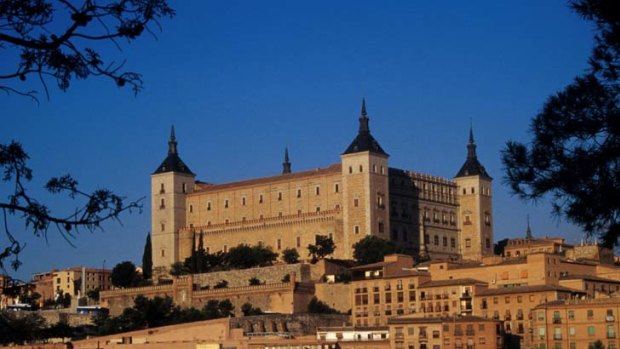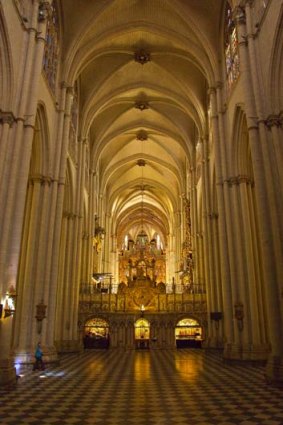This was published 12 years ago
The Mudejar mystique
From Visigoths to Moors to Christians and power-mad kings, Toledo wears its Castilian history with elan, writes Jack Watkins.

Honeypot ... Alcazar Fort.Credit: Getty Images
BARELY an hour from Madrid, Toledo is often an afterthought for visitors to Spain. Natives know better. They love the city surrounded by a ravine, courtesy of erosion by the Tagus River.
Toledo lost to Madrid in the race to become Spain's capital city in the 17th century but will always be the capital of mediaeval culture.
It has been adrift from mainstream Spanish affairs for at least 300 years but this grand Castilian city did have one last moment of modern headline-making, in the Spanish Civil War.

Toldeo cathedral.Credit: AFP
Spectacularly situated on a rock above the Tagus is the Alcazar. Now a museum, it was originally built by the Romans and renovated in the 16th century as an imperial fortress. In 1936, several Franco supporters defiantly holed up here and endured two months of Republican bombardment in the Siege of the Alcazar.
Walk around the foot of the ravine and you enter the main gate and northern entrance to the city, the Puerta de Bisagra.
A splendidly martial 16th-century affair, the gate is proudly emblazoned with the crest of the power-mad Charles V (Charles I to the Spaniards), the first Hapsburg emperor to rule Spain. One of many impressive gateways, it's a reminder that Toledo was for centuries a frontier town - taken by the Moors in 711 and not recaptured until 1085, by Alfonso VI of Castile, with El Cid by his side, during the Christian Reconquista. This period imbues Toledo with its special mystique, as many of its buildings are an attractive fusion of north European Gothic and Islamic, which combine to form a unique style known as Mudejar.
A good example, the church of Santiago del Arrabal, stands opposite the Puerta de Bisagra, its Gothic nave offset by Moorish horseshoe arches and patterned brickwork. Built in the 12th century, it is proof of the peaceful coexistence of Christians, Muslims and Jews in the post-Reconquista centuries that made Toledo a byword for cultural cross-fertilisation and tolerance.
As a honeypot for domestic tourism, the narrow, cobblestone streets of the old city can get chaotically overcrowded. The Plaza de Zocodover is the town's social hub, offering good people-watching territory from one of its roadside restaurants. Hover too long, however, and you may find yourself diving for cover as the little "train", its warning bells tinkling, shunts somewhat sheepish-looking trippers around the centre.
It's worth a little forbearance, though, to take an amble along Calle Comercio, where the shop windows are full of marzipan - the local delicacy - or, marking Toledo's metalworking traditions, ornate silverware in the form of armour, swords and knives. The second largest cathedral in Spain (and one of the most significant Gothic buildings in Europe) is nearby.
The Toledo cathedral's exterior lacks drama but wonders lie inside. The Transparente altarpiece is as overblown an example of mad Churrigueresque baroque (after the Spanish architect, Jose Benito Churriguera) as you're likely to encounter on the Iberian Peninsula.
The sacristy walls are filled with paintings that would distinguish a national gallery, including canvasses by Caravaggio, Titian, Raphael, Goya, Rubens, Velazquez and El Greco.
The latter lived in Toledo for many years and his works can be found in several of the city's museums and churches. You can visit his house but get there early as the queues can be long. Better, perhaps, to step along to the monastery of San Juan de los Reyes. It was founded by King Ferdinand and Queen Isabella in 1477 to commemorate their victory over the Portuguese army at the Battle of Toro and is an exquisite example of dainty Isabelline Gothic architecture. Its elaborate two-storey cloisters, encircling an orange tree-graced garden, are a delight.
From the terrace outside, enjoy stunning views across the Tagus Valley. Take the zigzagging path beyond the walls of the Puerta del Cambron - another of the city gates - and you arrive at the Mudejar hermitage of Cristo de la Vega. Its links hark back to another rich chapter of Toledo's heritage.
Here Reccared, the Catholic king of the Visigothic barbarians who conquered Spain in the 5th century, was converted to Christianity and the Visigoths held the councils that made Toledo their capital city.
In this lonely place you come face to face with Spain's Dark Ages, only to discover that things weren't so very dark after all. Back up on the hill, in the serious-sounding Museum of the Councils and Visigothic Culture housed in the utterly ravishing old church of San Roman, you can see examples of their art, sculpture and jewellery.
Trip notes
Getting there
Emirates flies from Sydney to Madrid via Dubai priced from $2566. 1300 303 777, emirates.com.
Staying there
Hotel Pintor el Greco, housed in a 17th-century building in the old Jewish quarter, has rooms from €60 a night. 925 285 191, hotelpintorelgreco.com.
More information spain.info.
Sign up for the Traveller Deals newsletter
Get exclusive travel deals delivered straight to your inbox. Sign up now.